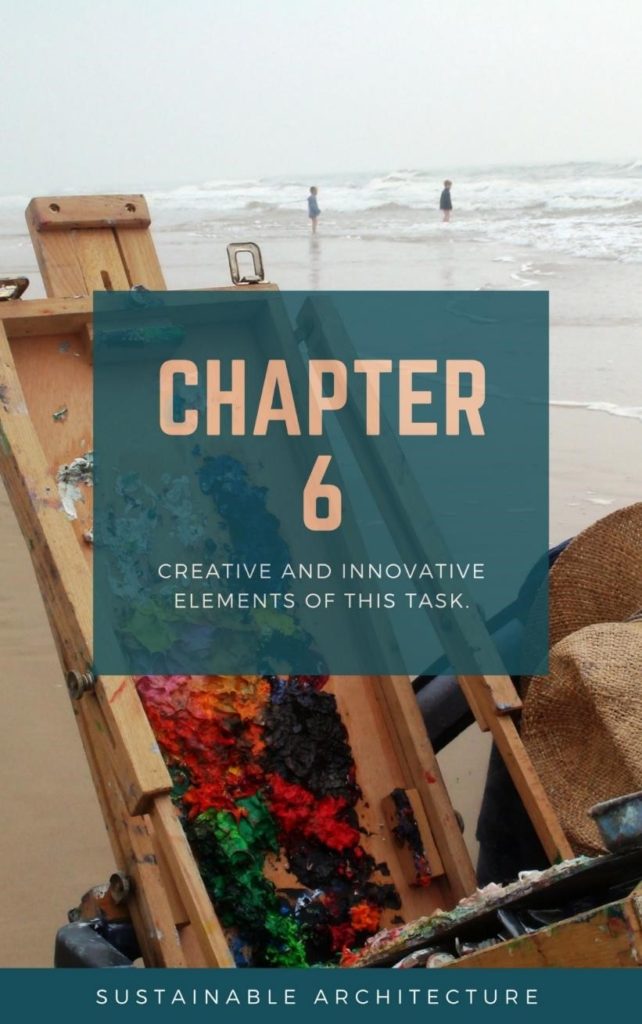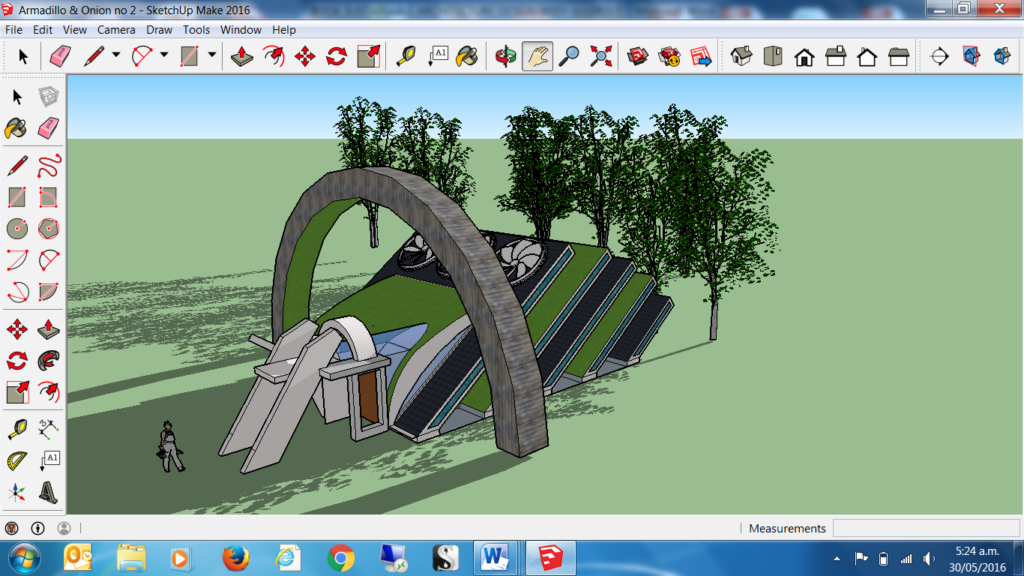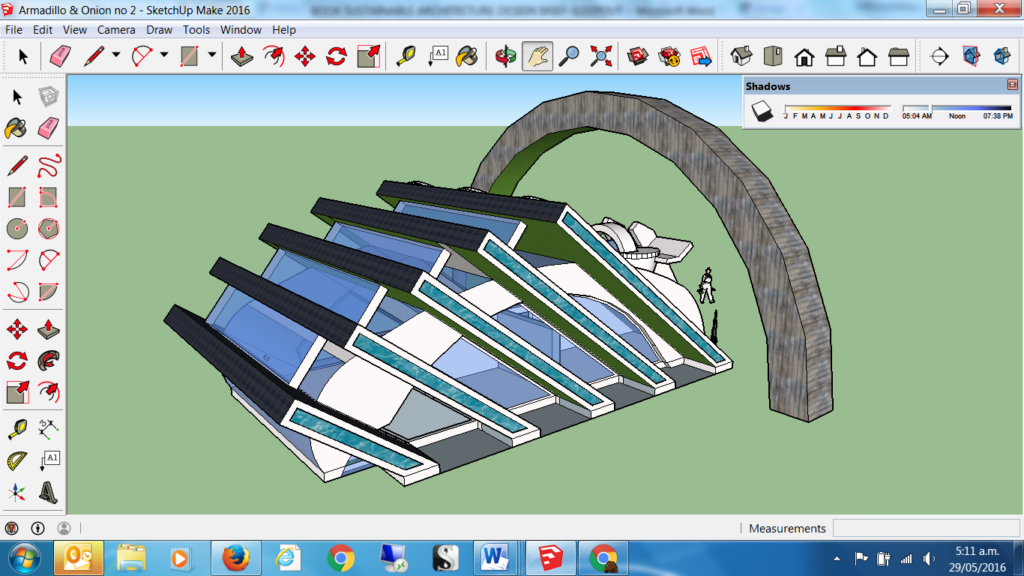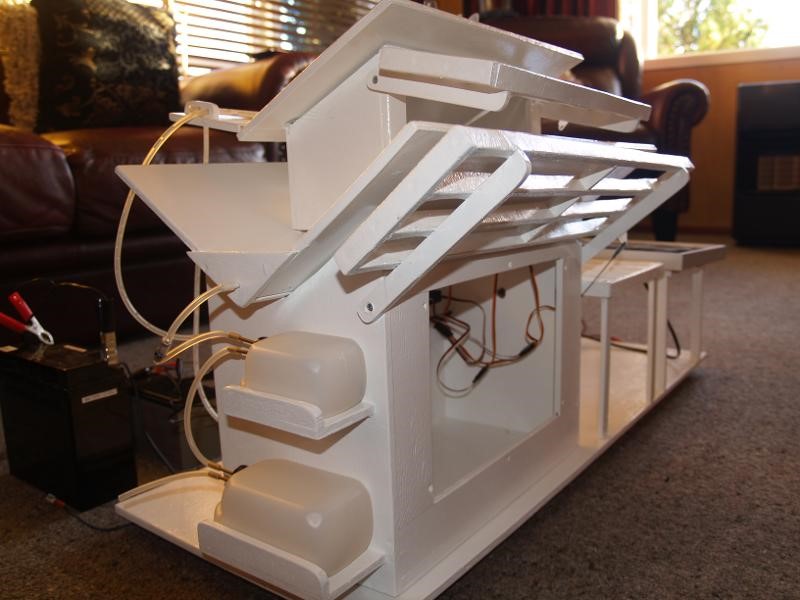$4.99
Book details:
223 x size A4 pages. 20,100 words including many images, diagrams, tables, charts, video links, and much more.
Introduction
This book was written with the intent to assist teachers, parents, caregivers, students, architects, designers, and those who are interested in Education for Sustainability, Environmental Education, Eco Education, Sustainable Architecture, and Design and Visual Communication. Sustainable architectural solutions are the focus. Three different sleepout solutions are discussed and illustrated. THIS BOOK IS SUITABLE FOR PRIMARY SCHOOL TEACHERS, SECONDARY SCHOOL TEACHERS, AND TERTIARY TUTORS.
The sleepout briefs and the solutions by 16-year-old students are:
1.The Egg Sleepout (egg-shaped, floating sleepout)
2. The Shipping Container Sleepout (Constructed by using 3 x shipping containers)
3. The Armadillo and Onion Inspired Sleepout (Focus on the biomimetic principles of the onion and the armadillo). Based on a Design and Visual Communication book by the author. Included free in this book.
BACKGROUND OF THE AUTHOR AND THE BOOK
As a practising Design and Visual Communication teacher, who has also practised Technical Drawing, ‘Ingenieur’s Grafika’ (Afrikaans), and Graphics, for the past 22 years, the author wanted to give back to students and teachers.
He has studied extensively over the past 15 to 20 years (education). He is qualified in Design and Visual Communication, Education for Sustainability, Technology Education, Innovations for STEM (Science, Technology, Environment, and Mathematics), Gifted and Talented, Research Methods and eventually completed a Master’s degree in Open Education, Global development Education, Peer-to-Peer collaboration (P2P), Peer Learning (PL), Peer Assisted Learning(PAL), and Peer-to-Peer Learning Technologies. The author has secondary school teaching experience of over 22 years in Technology Education.
The benefits for reading this book is that the contents focus on informing the reader about sustainable architectural practice, and then continues to give practical examples of how a typical sustainable design brief could be structured and planned. As mentioned, three different sleepouts are included to provide depth to the sustainable features and functions considered for each design brief.
Several resources are included in the appendices for the reader. The book contains different solutions to Sustainable Sleep-out design briefs. The author produced a systematic solution to the design briefs with a range of media and techniques, which the reader will find valuable. The resources include freehand sketches, illustrations, screenshots, drawings, Sketch-up design work, annotations, and YouTube video clips produced by the author specifically for this design brief. The resources will provide a solid starting point for readers either to attempt their own sustainable design projects or to teach sustainable architectural design.
Excerpt:

Chapter 6: Creative and innovative elements of this task
So what is so creative and innovative about this task?
The fact that the task requires different methods (online test, graphs, photography, freehand sketching, PowerPoint with discussion, group work, mobile phones), and media (computer software and art/drawing media) makes it quite challenging. The ‘creative and innovative challenge’ is the fact that the scope of this task broadens and deepens to a point where not only design principles (aesthetics, associated principles of design) plays a role, but properties of materials (e.g. building materials) and subsystems, e.g. wind turbines, solar panels, etc., takes centre stage. It challenges the design process further by asking the student to implement sustainable components and features as well as challenging the student to use biomimetics to extend the design possibilities, by exploring nature. It also includes some engineering challenges, for example, the movement of the roof or other components.
The group work, sharing of ideas and concepts, as well as the presentation by the group leader – or individual students – on screen (data projector), add to the development of the collaborative processes which supports peer learning and peer-to-peer collaboration. This process of interaction is a very important aspect of the collaborative process; however, the discussion of these processes are outside the scope of this book. For more details on peer-to-peer collaboration, see the academic papers on peer-to-peer collaboration (P2P), peer learning (PL) and peer-assisted learning (PAL) at https://fivehousepublishing.com/
Description
Preface
This book is about Design and Visual Communication for secondary school students and teachers. It is very useful for primary school teachers and students who are interested in sustainable architecture. Designers and architects could also find it an interesting read. The software Google Sketch-up, discussed and illustrated in this book, is very user-friendly. The computer-aided drawing program – Sketch-up – is freeware, which can be downloaded from the Internet. The program is very easy to use; very young kids, like primary school students, secondary school students, can use it. It is a great design program and many tertiary students, as well as professional architects and designers, make use of it. Included in the brief is general research (inspiration board, design eras & influential architects), and design activities that include possible solutions to a sustainable architectural design brief.
Extensive content is included on freehand sketches; Sketch-Up computer-aided drawings, elevations, site plans, diagrams, screenshots, biomimetics, assessments, and more are included. The assessment of the building site is presented, including weather and climate factors. Additionally, the author has included links to his YouTube videos (model/movement). These videos were specifically included to assist the solution to sustainable architectural briefs. Links to published academic work by the author, and much more, are included. See Five House Publishing for more details. Exemplars of secondary school student work (sixteen-year-olds) from a New Zealand Secondary School context are included.
Keywords & Key Phrases:
design and visual communication, 16-year-olds, sleep-out, sustainable architecture, sustainable features & functions, secondary school, sleep-out, shipping containers sleep-out, armadillo and onion inspired, biomimetics, ask nature how, passive solar design, the living classroom, model, movement, illustrate sustainable function, design eras, modernism, influential designers, modernist architects, generating design ideas, ideation, freehand sketching, ideation, Sketch-Up, computer-aided software, shadows and shading, passive solar, passive ventilation, clerestory, site assessment, weather, climate, harvesting energy from the sun, harvesting energy from the wind, collecting rainwater, location, retrofitting, creativity, innovation, thermal mass, heatsink, insulation, animal architecture, solar thermal panel, photovoltaic panel, eglass, green roof., heatsink, thermal mass, LED lights, carbon footprint, Māori, New Zealand
VOLUME 1
Contents
VOLUME 1. Page 12
Preface. Page 12
Keywords & Key Phrases: Page 13
Introduction. 16
Summary: 23
Links to primary schools: Sustainability Practice. 28
Chapter 1: A brief overview of sustainability in primary schools and the links to secondary school – a New Zealand context. 30
Chapter 2: A Māori or indigenous perspective on sustainable practice: Looking at the cultural diversity of New Zealand within an educational context. 33
Education for Sustainability in New Zealand Schools: Summary Report (2010) 36
References: 50
Bibliography. 51
Chapter 3: A quick view of biomimetics and some sustainable features and functions—Sustainable architecture design brief. 54
EXPLORING THE ONION (ORGANIC) AND ARMADILLO (ANIMAL) CONCEPTS TO INFORM DESIGN IDEAS FOR A SUSTAINABLE SLEEP-OUT. 55
PASSIVE SOLAR DESIGN: 56
What is PASSIVE SOLAR DESIGN?. 59
Sustainable sleepout design by a 16- year old student: ‘The Egg.’ 61
PASSIVE VENTILATION: ‘EARTHSHIP’ DIAGRAM… 65
Chapter 4: The situation, the brief, and the specifications: Sustainable Sleep-out 67
Chapter 5: Sustainable sleep-out design. A Design and Visual Communication approach from a New Zealand perspective (curriculum), including educational research to support this design process and to inform design decisions, educational models, strategies, assessment, and more. 80
Software used for design work: Google Sketch-up (free software – SketchupMake) 82
Curriculum task alignment 84
5.1 Planning for practice: 84
5.2 Brief development: 85
5.3 Outcome development and evaluation: 85
5.4 Technological modelling: 85
5.5 Technological products: 86
5.6 Technological systems: 86
5.7 Characteristics of technology: 86
5.8 Characteristics of technology outcomes: 86
5.9 Biomimetics: 87
Chapter 6: Creative and innovative elements of this task. 91
Design Competition for students: 93
Chapter 7: Why this task?. 95
Chapter 8: Carbon footprint 97
The intention is to explore the multi-media options for this task. 97
Chapter 9: A competition with prizes. 100
Chapter 10. Pedagogical Content Knowledge (PCK) 103
Chapter 11: ‘The living classroom,’ a living example of the application of PCK. 107
The Living Room.. 107
Wine bottles to insulate the floor. 108
Chapter 12: How the activities have been chosen and ordered. 115
Chapter 13: The planning of student’s learning—Models of learning. 118
BEHAVIOURIST LEARNING MODEL- Ivan Pavlov (1849-1936), John B. Watson (1878-1958) & B. F. Skinner (1904-1990): 118
DEVELOPMENTAL LEARNING MODEL: 123
Cognitive Theory – Jean Piaget (1896-1980): 123
The 4 Stages of Cognitive Development as developed by Piaget. Piaget identified four stages of cognitive development: 124
Sensorimotor stage (Infancy). 124
Pre-operational stage (Toddler and Early Childhood). 124
Concrete operational stage (Elementary and Early Adolescence). 124
Formal operational stage (Adolescence and adulthood). 125
Sustainability. 125
Summary of Maturation Learning Model 126
Humanistic Learning Model: 126
Humanist Theory: 127
Sustainability: 128
SOCIAL CONSTRUCTIVIST: 128
Socio-cultural Theory. 128
ENACTIVIST: LEARNING IS EXPERIMENTAL, REQUIRING PEOPLE TO ACT ON THEIR WORLD. 129
Chapter 14: Justification and ordering of tasks chosen. 132
Chapter 15: Assessments. 136
A summary of possible assessments: 136
Chapter 16: Possible extension of work. 139
Chapter 17: The next steps forward. 141
Chapter 18: Useful websites: 143
Great websites to visit (links): 144
CHAPTER 19: SUSTAINABLE ARCHITECTURE DESIGN BRIEF – The Armadillo and Onion Inspired Sustainable Sleep-out. 146
Sustainable features and functions phrases: 147
Step 1: Doing research: Armadillo and onion inspired sleep-out 149
Onion (scientific facts, shape & form) 150
Armadillo & onion ideation: 160
‘How To Think Like An Architect: Designing From Organic Form’ -by Barry Berkus: 161
THE PINK FAIRY ARMADILLO.. 170
The onion shape and form: 174
Freehand sketches that illustrate the concept idea for the solution to the brief: 175
Working with shadows and shading in SketchUpMake: 177
The 3D Warehouse in Sketch-up. The application of deciduous landscaping (trees). 180
Geo-location of your building in SketchUpMake. 183
Orientation of the sleep-out on the building site. 191
The Sketch-up model: Quick description of the different features and functions: SUSTAINABLE SLEEP-OUT. 194
ILLUSTRATION OF CONCRETE FORMWORK: See the video and the image below on the traditional method of pouring concrete into a steel shutter boxes (formwork) for a basic wall: 194
Green roof areas: 197
Living walls (interior): 199
Doors (interior and exterior): 201
Photovoltaic panels (solar panels): 201
LED Lighting: 201
Water tanks: 203
Sleep-out model in Sketch-up: Shadows and shading. 205
Link to Sketch-up website: 206
END OF VOLUME 1. 213
PREVIEW: THE CONTENTS OF VOLUME 2. 214
ABOUT THE RESEARCHER (AUTHOR): 220
See more eBooks by the author available at: Page 221
APA REFERENCING AND CITATION: Page 222
Additional resources available related to this book by the author. Page 223


3. ARMADILLO AND ONION INSPIRED SLEEPOUT:

Sleep-out model in Sketch-up: Shadows and shading
The next couple of screenshots show the shadows not activated and then activated including the deciduous trees. The time is early morning, and two alternatives are shown to illustrate summer and winter solstices. Note that the sun is higher during summer, compared to winter when the sun sits lower in the sky. The effect is clear in the images below. The ideal is to design a sleep-out that allows sun into the building during winter (heat up the heatsinks), and during summer you want to keep the building cool. To keep the building cool during summer you have to look at the roof overhangs (shading), the height, quantity, and density of the deciduous trees, and possible movement of the roof. The movement used in this design is very simple, for example, the glass panels, which sit perpendicular to the slanted roof (main) structure, can open and close on demand. It means that when these ‘covers’ are closed; less sun will enter the building. When the covers are open more sun will enter the building. See the images below for details. Visit the YouTube channel of William van Zyl to access several videos that explain these concepts and ideas. These tutorials are ideal for students to learn about the architectural and design principles discussed in this book. Also, see Sketch-up tutorials available on YouTube and the Sketch-up website.

Sketch-up: Outside 3-D view of the completed sleep-out without shadows. Roof openings are facing north to maximise the amount of sun that could reach the building during winter. However, deciduous trees (not shown here) would provide additional shading during summer (trees full of leaves). The sun would heat up the concrete floor and concrete walls and concrete roof. Credit: W van Zyl.

The above model (partially completed): Illustrates the passive solar functions, movement, and some other sustainable features and functions. See the water tanks (white translucent plastic aircraft tanks situated at the front) which store the rainwater harvested from the roof. The louvres move up and down remotely and act as a sunscreen to manipulate the amount of sunlight that enters the building at any given time through the windows. A model plane remote control system controls some of the movement of the components in the model (louvres). Ebook illustrating the Model in detail (including the functions) are available at https://fivehousepublishing.com/
Related products
-

River Rights: A United Approach to Improve Sustainable Practice.
$0.00 Add to cart -

I am a ‘STEAM’ Architect (Science, Technology, Engineering, Art & Mathematics).
$0.00 Add to cart -

MINECRAFT LESSON: EDUCATION EDITION ‘Create a Mausoleum, or a tomb, or a burial site in Minecraft Edu’
$0.00 Add to cart -

LESSON: Use the work of an influential designer to inform design ideas. Design a Moon-base on Minecraft Education – focus on Aesthetics and Function.
$0.00 Add to cart

